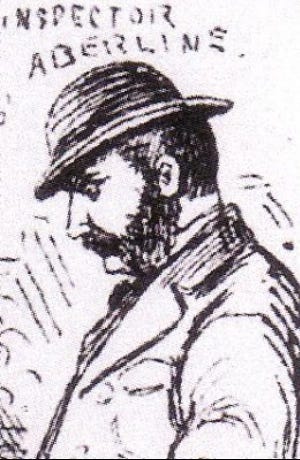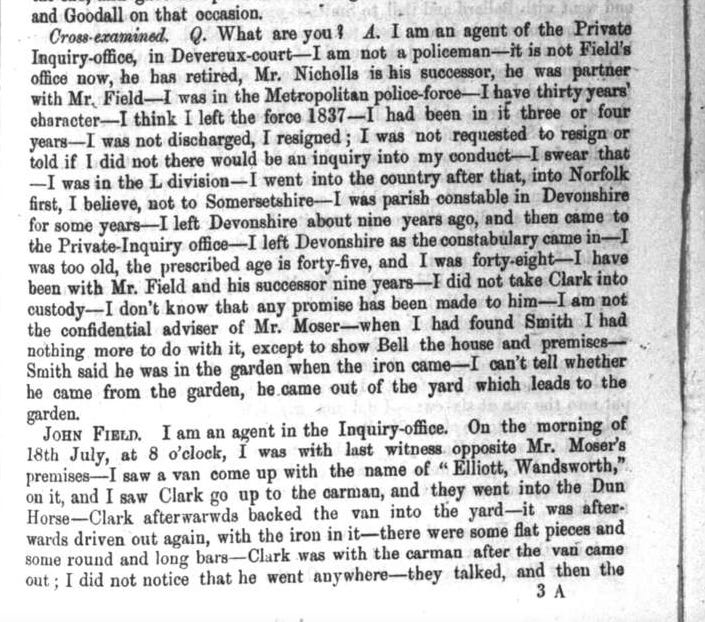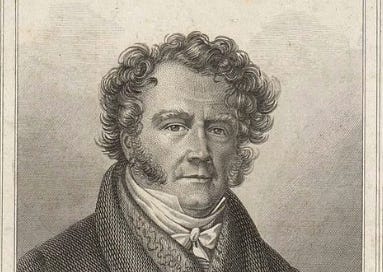In the stories that appear on The Casebook of Adam Cole, the title character is a jobbing private investigator, or “private enquiry agent” as they were often known in the Victorian-setting they inhabit. Most of his cases are handed to him through the legal chambers of Mr. Edward Sacker, a solicitor in Middle Temple Lane, located down a vaulted tunnel off the Strand. Not a salaried man, Cole instead earns his daily pennies on a case-by-case basis, calculated, of course, after Sacker takes his sizeable cut. His cases range from domestic accounts of infidelity, to missing persons, to insurance frauds, to theft, leading, often indirectly, all the way to murder. Though not based on any real-life inspiration, Cole is derived from a legacy of private investigators that popularized the field throughout the Victorian Era by pounding the mean (cobbled) streets of gaslit London.
Private enquiry agents as a recognized occupation were already more than 50 years old by the time of the 1880’s setting of the Cole stories. One of the earliest practitioners was Eugene Vidocq (1775-1857), a French criminal who turned his life around and used his insights to investigate rather than instigate illegal activities. While predating the start of the Victorian Era, he developed various methods that redefined criminal investigations in the decades that followed, including molding plaster casts of footprints, using chemical analysis and disguises, and indexing specific details about prisoners so they could be better identified if they reoffended. His 1828 memoirs expounded his adventures as an amateur “criminalist” and went on to become a bestseller, inspiring Poe when creating his Parisian sleuth C. Auguste Dupin in The Murders in the Rue Morgue in 1841 and Hugo when developing criminal turned policeman Javert for Les Misérables in 1861. His legacy lives on to this day through the Vidocq Society, a Philadelphia-based volunteer group of former law enforcement members, forensic scientists, and others with expertise in crime solving who turn their skills toward cracking cold cases. The membership of the society never goes beyond 81, keeping within the number of years of Vidocq’s life.
The first notable English private investigator was Charles Frederick Field (1805-1874). A former Metropolitan London (Scotland Yard) police inspector, he retired from the official force in 1852 and established his own private enquiry agency. He had wanted to be an actor before turning to policing, but his theatricality, if it failed him on stage, was said to have followed him into the latter career, with his gruff tone and flagrant gestures impressing all who encountered him. His reputation as a competent policeman together with the admiration he received from Charles Dickens, who fictionalised Field as Sgt. Bucket in Bleak House, helped to bolster Field’s venture. His efforts, however, hit a sour note with the police as Field insisted on continuing to be called “Inspector,” a title reserved for officials within the Detective Department of Scotland Yard. Despite reprimands and even a temporary pause on his pension, Field would not relent.
As his agency grew, Field hired a young Hungarian-born man named Ignatius Pollaky (1828-1918) who established his own firm in Paddington Green called Pollaky’s Private Inquiry Office. This earned him the name “Paddington Pollaky” and he became an early user of the newspapers’ advertising columns to promote his services which he offered both in England and on the Continent. He promoted “discreet inquiries” in matters of “divorce and cases of libel.” It’s claimed he also conducted surveillance on behalf of a US Ambassador during the American Civil War to track Confederate agents who were buying arms in the UK. He was further known to collect intelligence for Scotland Yard on illegal aliens living in London.
Amateurs such as William Henry Burgess and William Robinson set up shop with a focus on cases involving divorce and bigamy and other county court matters, which are all typical fare for enquiry agents both then and now. Meanwhile, Charles Grand and J.H. Batchelor started a firm at 238 The Strand and quickly injected themselves into the investigation surrounding the notorious Jack the Ripper in the autumn of 1888. They offered their services to the local vigilance committee as well as the Evening News and, following the murder of Elizabeth Stride on 30 September at Dutfield’s Yard, St. George’s-in-the-East, developed what first appeared to be important clues. These came in the form of a blood-stained grape-stalk and a witness, greengrocer Matthew Packer who claimed to have sold the grapes to Stride and her killer. This put Packer in the valuable position of having seen and spoken to the mysterious murderer. The police were criticized for over-looking Packer while Grand and Batchelor were lauded. Unfortunately, the clue and witness made for better media fodder than actual evidence. Packer, it turned out, was likely a liar (or an unreliable witness at best), more addicted to his newspaper fame than catching the killer. The police ended up finding little of value in what Grand and Batchelor reported to have uncovered, and the entire field of Ripperology has been permanently stained by the made-up claims of Packer and his infamous grapes. Little more is known about Batchelor, while Grand would later go on to face accusations of fraud of his own, and his reputation as an investigator was as dubious as the rest of his clouded history. Recent theories suggest he may have even been the Ripper.
Speaking of Jack the Ripper, Scotland Yard’s Inspector Frederick Abberline (1843-1929) played a role as one of the investigation’s key detectives. In 1887, he had been promoted out of H Division (Whitechapel) to headquarters, however his knowledge of the Ripper’s hunting ground saw him placed back in Whitechapel to lead the force there. While he never caught his quarry, he was notable for many other accomplishments in his long career for which he earned 84 commendations. On his retirement from the official detective force in 1892, Abberline set up his own private enquiry agency which he operated until 1898. In this time, he spent three seasons in Monte Carlo investigating thieves and cheaters at the hallowed gambling halls of the French resort. In 1898, he entered the European branch of the American-based Pinkerton’s Detective Agency until finally retiring in 1904.

Little is known about the finer details and methods of private enquiry agents from the era. Unlike official police records, the reports and manuals kept by investigative firms do not seem to have survived. Indeed, the agents of this deep-shadowed profession remain lost to the shadows they created. Court records reveal a few particulars here and there, and a search of the transcripts of the Old Bailey (the London-based Central Criminal Court of England and Wales) for the period turn up bits and pieces where private investigators were involved in judicial proceedings. For instance, an August 1865 investigation run by agents William Ballard and John Field of a “Private Inquiry” office based in Devereaux Court, The Strand, focused on a workplace theft. Testimony describes their surveillance on the activities of John Clark who was stealing iron from his employer and absconding with it to the property of Thomas Smith. The observational evidence of Ballard and Field – who watched as Clark, between pub stops, ran a cart-load of iron from his employer’s yard to Smith’s – helped achieve a conviction for Clark and Smith, the first receiving nine months and the second eighteen months, for their actions.

In the 19th Century private investigating was a profession dominated by men, many of whom were ex-policemen, or even criminals in the case of Vidocq. Really, anyone with curiosity and initiative and with a mind for puzzles and justice could enter the quagmire of amateur detective work. Their ambition and success would determine whether they stayed in it for very long. Unlike what a lot of fiction, including my own, imples, murders and other high-profile crimes would rarely drag in private detectives, with the police holding tight reins over these investigations. Instead, the “amateur” enquiry agents would often be tasked with smaller domestic matters, such as infidelity cases and workplace thefts, or chasing down debtors and locating missing persons. Often, the work involved tedious days and nights doing surveillance work from street corners and doorways in all manner of weather conditions. This involved hoofing it across London’s streets, hopping in and out of trains and omnibuses, and slipping into shops and restaurants and other businesses, hoping to keep a low profile while keeping an eye on the subject and whatever (mis)deeds they were involved in. There would also be enquiries that required knocking on doors, asking questions, and collecting statements. A private investigator would be used to dig into matters of due diligence, or for developing witnesses for legal briefs in defendant trials. Basically, any legal role outside of or beneath the standard purview of the police.
The popularity of private and amateur detectives in fiction exploded in the Victorian Era, starting with Poe’s Dupin, growing into Walter Hartright and Marian Halcombe in Collins’s The Woman in White, and culminating with the creation of Doyle’s consulting detective Sherlock Holmes in 1887, to name a scant few. They have never gone away either, continuing to propagate well beyond the era of their settings in the works of Anne Perry, Caleb Carr, Lyndsay Faye, Will Thomas, Alex Grecian, and on and on. All these fictional influences will be granted their own article.
While private enquiry firms continue to flourish around London to this day, as in the Victorian Era the United Kingdom does not maintain a governing body for private enquiry agents and no licensing is needed. This is a stark contrast to Canada and the United States, where screening at the provincial and state levels ensure those who wish to work in the industry pay fees, fill out forms, file insurance, maintain clean criminal records, and carry official documentation to identify themselves as investigators. Instead, in the UK many enquiry agents rely on “good-standing” by coming from law enforcement or military backgrounds, or by gaining experience under established firms with notable reputations. As with Cole, they rely on little more than business cards to identify themselves as private investigators. And unlike the Victorian Era, male and female investigators now share the industry and come from a range of ethnic backgrounds.
— R.R. Scott
Sources:
Article: “Britain’s First Modern Private Investigators?”. EJM Investigations. 14 December 2017. Website: https://www.ejminvestigations.co.uk/blog/britains-first-modern-private-investigators/
Article: “Eugene Francois Vidocq.” Wikipedia. Accessed 19 April 2024. Website: https://en.m.wikipedia.org/wiki/Eugène_François_Vidocq
Jones, Richard. “Inspector Field.” Article: Jack The Ripper Tour: A Walk Worth Investigating. 14 December 2015. Website: https://www.jack-the-ripper-tour.com/generalnews/inspector-field/
Griffin, Rachael. “The Real PIs of Victorian London.” Victorian Detectives. 3 September 2013. Website: https://victoriandetectives.wordpress.com/2013/09/03/the-real-pis-of-victorian-london/
Old Bailey Proceedings Online (www.oldbaileyonline.org, version 9.0) August 1865. Trial of JOHN CLARK (29), THOMAS SMITH(36), (t18650814-815). Available at: https://www.oldbaileyonline.org/record/t18650814-815?text=%22private+inquiry%22 (Accessed: 19th April 2024).
Old Bailey Proceedings Online (www.oldbaileyonline.org, version 9.0) November 1881. Trial of SARAH MORRIS (26), JOHN DAVIS (28), JOSEPH ONLEY (22) (t18811121-58). Available at: https://www.oldbaileyonline.org/record/t18811121-58?text=private+enquiry (Accessed: 19th April 2024).
Wikipedia contributors. "Ignatius Paul Pollaky." Wikipedia, The Free Encyclopedia. Wikipedia, The Free Encyclopedia, 17 Feb. 2024. Web. 19 Apr. 2024.





